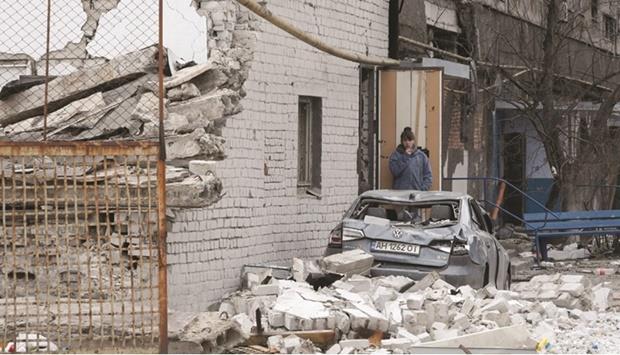
Innovative Finance Can Help Rebuild Ukraine
Estimates of Ukraine's postwar reconstruction costs vary widely. Ukrainian Prime Minister Denys Shmyhal recently put the likely bill at $750bn, while European Investment Bank President Werner Hoyer thinks the country may need $1.1tn. Every day that the war continues, the figure increases.
Ukraine will need to rebuild power stations, electricity grids, and critical water, sanitation, and transport infrastructure. Industry will require investments, and houses will need to be rebuilt and repaired before the winter – although many cities, towns, and villages have been completely destroyed.
But Ukraine will not be able to finance such a massive investment program on its own and should not count on reparations from Russia. Financing must therefore also come from multilateral development institutions such as the World Bank, the European Investment Bank, and the European Bank for Reconstruction and Development. Western governments will have to contribute as well, as will the European Union (EU).
The biggest problem is that Ukraine will need the money as soon as the war is over. Because the country does not have sufficient reserves of its own, it will have to borrow. But its sovereign creditworthiness will be at rock bottom after the war, even though Fitch Ratings recently upgraded Ukraine from RD (restricted default) to CC.
Furthermore, Western governments will not be able simply to transfer an initial $100bn overnight to Ukraine. Their finances are still reeling from fiscal measures to counter the effects of the Covid-19 pandemic and the newfound realisation that they need to spend more on defence. Germany alone intends to invest an additional €100bn ($101bn) in its military.
But innovative financing mechanisms can help to bridge at least some of Ukraine's massive funding gap. Policymakers should consider two recent precedents in particular.
One promising option is to set up an International Finance Facility for the Reconstruction of Ukraine (IFFRU). This would be modelled on the International Finance Facility for Immunisation (IFFIm), which was established in 2006 by several donor governments under the leadership of the United Kingdom to provide up-front money to vaccinate children in the world's poorest countries.
The IFFIm received legally binding multiyear pledges totalling over $6bn from highly rated governments, enabling it to obtain a AAA rating and start borrowing in international bond markets. The borrowed funds – the IFFIm's first bond issue amounted to $1bn – were sent to Gavi, the Vaccine Alliance to finance immediate large-scale immunisations.
The tax-exempt IFFRU would be based outside Ukraine and function in accordance with best-practice operational and governance standards. And rather than diverting huge sums of money out of their current budgets, many Western governments will be able to make legally binding commitments over 20 years. If correctly structured, the sums would be included in the respective government budgets only in the year they are due.
Depending on the donor countries' credit ratings and the facility's financial policies, the IFFRU could have a rating of AA or better. That would enable it to tap international bond markets and front-load financing for Ukraine, disbursing money as and when the country needs it. In this way, infrastructure and desperately needed housing for Ukraine's displaced population can quickly be rebuilt.
A second possibility is for Ukraine to issue Brady bonds, following the example of some emerging markets – including several Latin American countries, Bulgaria, Morocco, Nigeria, Poland, and the Philippines – when they defaulted on commercial bank loans three decades ago. To resolve the crisis, the banks accepted a haircut, or certain loss, on the loans, and the remaining debt was converted into tradable sovereign bonds, with principal repayments collateralised and thus secured by specially issued government securities. In the case of dollar-denominated Brady bonds, the US Treasury issued special 30-year zero-coupon securities to provide such collateral, making the bonds attractive to investors.
Ukraine, whose CC rating will prevent it from tapping international debt markets on its own, could use a similar structure to kick-start its bond-issuance programme. The government would be responsible for paying the interest on its Brady bonds – with the necessary foreign exchange coming from the country's taxpayers – and the principal repayments would be collateralised or guaranteed by zero-coupon bonds issued by highly rated governments, the EU, or other entities. Ukraine would have to purchase these zero-coupon bonds, or governments wishing to support the country's reconstruction could donate them.
Rising interest rates and tight government budgets mean that the large sums needed to rebuild Ukraine cannot be raised in one go. But creative financing mechanisms can help to reduce the strain and accelerate the country's reconstruction. – Project Syndicate
* Marcus Fedder, a former director of the International Finance Facility for Immunisation and a former treasurer of the European Bank for Reconstruction and Development, structured Brady bonds when he worked for the World Bank in 1990-91.

Legal Disclaimer:
MENAFN provides the information “as is” without warranty of any kind. We do not accept any responsibility or liability for the accuracy, content, images, videos, licenses, completeness, legality, or reliability of the information contained in this article. If you have any complaints or copyright issues related to this article, kindly contact the provider above.






















Comments
No comment